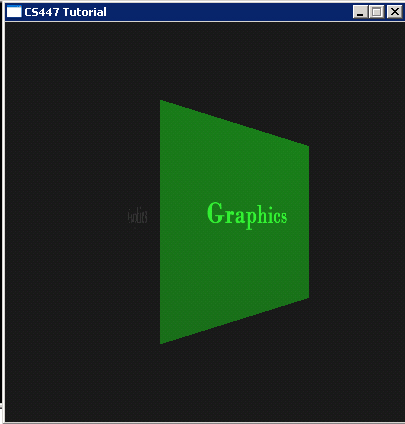Step 3: Load and Bind a Texture
Ok we're ready to load our image and use it as a texture. We're
going to add a couple of helper methods to make this easier, one to
load the image and one to resize it for us. We'll also need a
member variable to track the id number of the texture object we'll need
to use the texture in OpenGL. Add the following method
declarations and the member variable declarations to MyWindow.h..
. . |
If we're going to use the TargaImage class we'll have to include its declaration. We'll add it near the top of MyWindow.h.
#ifndef
MY_WINDOW_H |
We need to add definitions for our two helper functions. Let's look at LoadTexture() first. You'll need to add it to the bottom of MyWindow.cpp.
void
MyWindow::LoadTexture(const char* filename) |
We'll take a quick look at what LoadTexture() does for us, however I won't be covering the OpenGL functions in detail. I'd recommend the "red book" (OpenGL Programming Guide) for an explanation of texture mapping and how it is achieved in OpenGL. LoadTexture() takes the filename of the targa to load as its only argument. It attempts to load the image via TargaImage and quits if this fails. Image formats generally place the origin in the upper left corner of the image, where as texture coordinates assume the origin is in the lower left. To account for this difference we're going to flip the image after we load it. TargaImage provides a method to do this, Reverse_Rows().
OpenGL places some restrictions on the format of images which will be used as textures. First the minimum size of each dimension of the texture must be at least 64. Textures must also have dimensions that our powers of two. The textures need not be square only a power of two in each dimension. We'll add a helper method, ResizeImage(), to make our images comply with these restriction.
Once we've resized the image we create and bind an OpenGL texture object via glGenTextures() and glBindTextures(). We then load our image as a texture with glTexImage2D(). Our texture can now be referenced via the texture object we've bound it to. Please refer to the "red book" (OpenGL Programming Guide) for help with these functions.
Below is the code for the ResizeImage() method. I won't cover this code other than to say that it utilizes a function from the OpenGL utility library, gluScaleImage() to actually resize the image. You'll need to add the function definition to the bottom of MyWindow.cpp.
bool
MyWindow::ResizeImage(TargaImage* image) |
We'll need to add a couple of includes to MyWindow.cpp.
.
. . |
Add add an actual call to LoadTexture() to the end of InitializeGL().
.
. . |
Also grab the image we'll be using as our texture and save it in your project's directory.
Note: you need to put graphics.tga in the right path depending on your project settings.
Step4: Add Texture Coordinates
void
MyWindow::DrawCube() |
Step 5: Build and Run the Program
Ok we're ready to build and run our program. Choose Build -> Build Solution to compile and link the program and Debug -> Start Without Debugging to run it. |
 |
Source code for this tutorial.
Go to the previous tutorial.